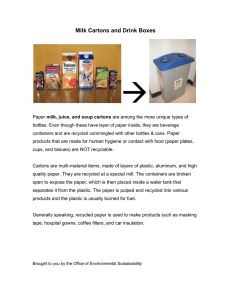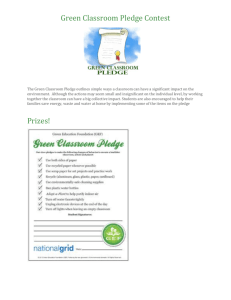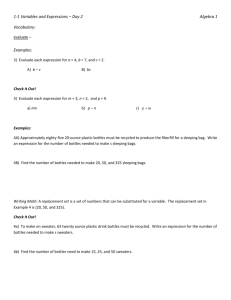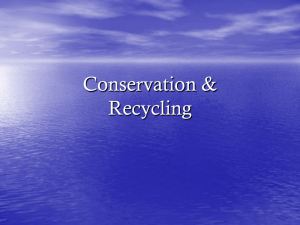Conservation/Recycling
advertisement
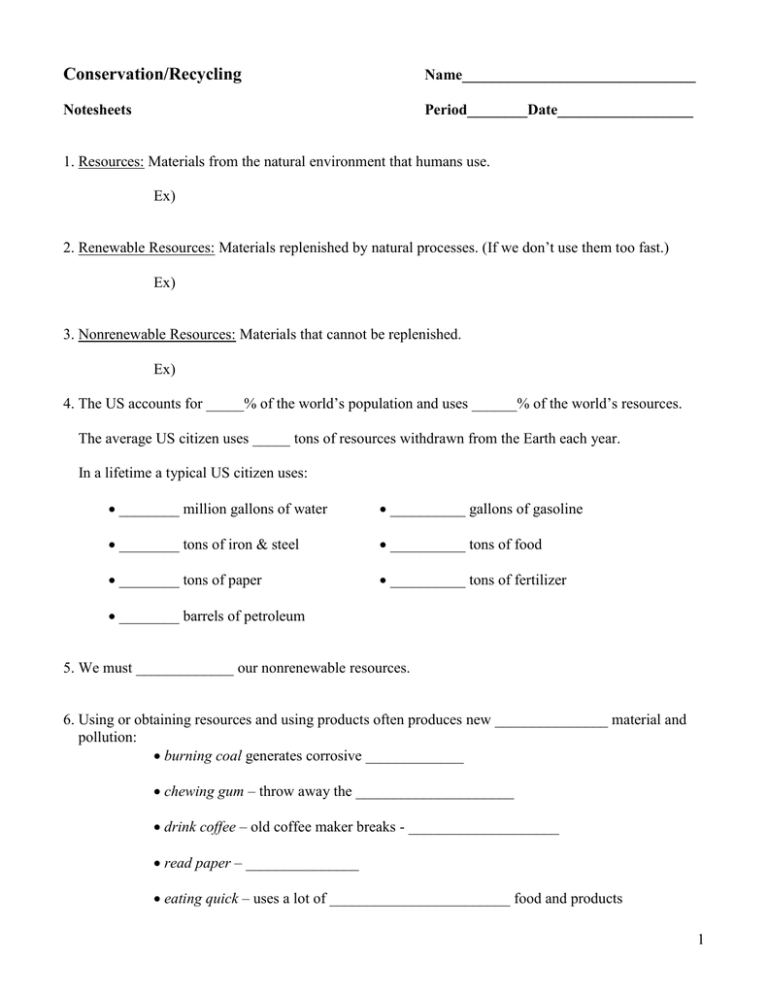
Conservation/Recycling Name_______________________________ Notesheets Period________Date__________________ 1. Resources: Materials from the natural environment that humans use. Ex) 2. Renewable Resources: Materials replenished by natural processes. (If we don’t use them too fast.) Ex) 3. Nonrenewable Resources: Materials that cannot be replenished. Ex) 4. The US accounts for _____% of the world’s population and uses ______% of the world’s resources. The average US citizen uses _____ tons of resources withdrawn from the Earth each year. In a lifetime a typical US citizen uses: ________ million gallons of water __________ gallons of gasoline ________ tons of iron & steel __________ tons of food ________ tons of paper __________ tons of fertilizer ________ barrels of petroleum 5. We must _____________ our nonrenewable resources. 6. Using or obtaining resources and using products often produces new _______________ material and pollution: burning coal generates corrosive _____________ chewing gum – throw away the _____________________ drink coffee – old coffee maker breaks - ____________________ read paper – _______________ eating quick – uses a lot of ________________________ food and products 1 7. Land Fills: Garbage can be ________________________ out of place. The average US citizen “throws away” _______lbs of garbage per day. _______lbs of this is paper. 80% of land fills will be filled within _______ years! Time to decompose in a landfill can be very long. US disposes of 1.1 million tons of _____________________________ per year US disposes of 250 million _____________ per year How long does it take for a glass bottle to decompose? napkin – newspaper – _______ years plastic bag – _______ years nylon fabric – _______ years tin cans – plastic 6-pack rings – _______ years _______ year _______ years plastic cup – _______ years aluminum cans – _______ years glass bottle – ____________________ years 8. Five R’s of Conservation: ________________ – use something different instead ________________ – repair/refurbish - use longer ________________ – reprocess to use again ________________ – how we act/habits in conserving (buy in bulk) ________________ – use less of each resource 9. Benefits of Recycling More: _________________ waste storage problem (landfill space) _________________ demand for nonrenewable resources _________________ price for nonrenewable resources _________________ pollution _________________ energy/$ _________________ jobs 2 10. Recycling Materials Examples: A. Paper ______________________ resource (25 years). Average US citizen uses ________ trees per year. ____________the energy required to process recycled paper. Only _______% of our paper is recycled. B. Aluminum _________________________ resource. US imports _______% of our Al. Recycling Al takes only __________% of the energy needed to produce Aluminum from its ore. _______% of our Aluminum cans are recycled. C. Glass __________________________ resource made from _________________. ___________% of our glass is made from recycled glass. D. Plastic __________________________ resource made from ______________________. The _________________ inside the chasing arrows symbol on the bottom of the plastic is the key to the type of plastic. The _______________ the number – the _______________ it is to recycle. Polyethylene Terephalate – tough and lightweight. Accounts for _____% of all plastic. Used for ______________________ and many other foods. Can be recycled into fabric for clothing, athletic shoes, luggage, upholstery, furniture, carpet, fiberfill for sleeping bags and winter coats, luggage racks, bumpers, and grilles. High Density Polyethylene – tough and stiff. Accounts for _______% of all plastic. Used for __________ containers and many other foods. Can be recycled into drainage pipe, liquid laundry detergent bottles, oil bottles, pens, benches, doghouses, recycling containers, floor tile, picnic tables, fencing, lumber, and mailbox posts. Therefore ______% of all plastic is #1 and #2 which can be recycled easily! 3 Polyvinylchloride (PVC) – tough and grease resistant. Used for ______________ cleaner bottles, cooking oil bottles, detergent bottles and siding. Can be recycled into binders, decking, paneling, mud flaps, roadway gutters, flooring, cables, speed bumps, and mats. Low density polyethylene – flexible and transparent. Used for ___________________ bottles, bread bags, frozen food bags, tote bags, clothing, furniture, dry cleaning bags, and carpet. Can be recycled into floor tile, garbage can liners, shipping envelopes, furniture, compost bins, paneling, trash cans, lumber, and landscaping ties. Polypropylene – tough and low density. Very heat resistant – can be used for yogurt containers, ________________ bottles, ketchup bottles, caps, straws and medicine bottles. Can be recycled into signal lights, battery cables, brooms, brushes, auto battery cases, ice scrapers, landscape borders, bicycle racks, rakes, bins, pallets, and trays. Polystyrene – good insulator, low melting point. Used for __________ &, ____, cutlery, meat trays, egg cartons, carry-out containers, aspirin bottles, and compact disc jackets. Can be recycled into insulation, light switch plates, egg cartons, vents, rulers, foam packing, and carry-out containers. Other – can be a combination of any of the 6 types of plastic or an unnumbered container. Can be used for three and five gallon water bottles, and certain food product bottles. It is recycled into plastic lumber, and other custom-made products. 4

